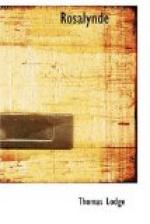Of this balance Lodge’s “Rosalynde” affords abundant illustration. Such a succession of sentences as that on page 7, where each sentence is composed of balanced clauses, is a striking but by no means unique example. Usually the contrasted words begin with the same letter or sound, as in the sentences just cited, where the alliteration appears to be employed to emphasize the contrast. Often the alliteration serves merely for ornament, as in the sentence: “It is she, O gentle swain, it is she, that saint it is whom I serve, that goddess at whose shrine I do bend all my devotions; the most fairest of all fairs, the phoenix of all that sex, and the purity of all earthly perfection.”
The euphuistic similes were of three kinds. First, there were those drawn from familiar natural objects, such as, “Happily she resembleth the rose, that is sweet but full of prickles.” Secondly, there are those taken from classical history and mythology, like these: “Is she some nymph that waits upon Diana’s train, ... or is she some shepherdess ... whose name thou shadowest in covert under the figure of Rosalynde, as Ovid did Julia under the name of Corinna?” Thirdly, there are those similes most characteristic of euphuism, though less commonly found than the two kinds just mentioned, namely, those drawn from “unnatural natural history.” Such are the comparisons to “the serpent Regius that hath scales as glorious as the sun and a breath as infectious as aconitum is deadly,” to “the hyena, most guileful when she mourns,” to “the colors of a polype which changes at the sight of every object,” and to “the Sethin leaf that never wags but with a southeast wind.”
One of the Last Examples of Euphuism. When Lodge wrote “Rosalynde,” euphuism was already on the wane. Even among Lodge’s contemporaries the fashion was becoming an object of frequent ridicule. Thus Warner, in his “Albion’s England” (1589), complains in the preface, which, by the way, is written wholly in the euphuistic manner: “Onely this error may be thought hatching in our English, that to runne on the letter we often runne from the matter: and being over prodigall in similes we become less profitable in sentences and more prolixious to sense.”
By 1627 euphuism had become an obsolete fashion. In that year Drayton wrote of Sidney that he
did
first reduce
Our tongue from Lillies writing
then in use:
Talking of Stones, Stars,
Plants, of Fishes, Flyes,
Playing with words and idle
Similies
As th’ English Apes
and very Zanies be
Of everything that they doe
heare and see,
So imitating his ridiculous
tricks,
They spake and writ like meere
lunatiques.
“Rosalynde” marks the end of the unquestioned supremacy of euphuism as a literary mode. It was the last book of any importance to employ the style that Lyly had made so popular.




